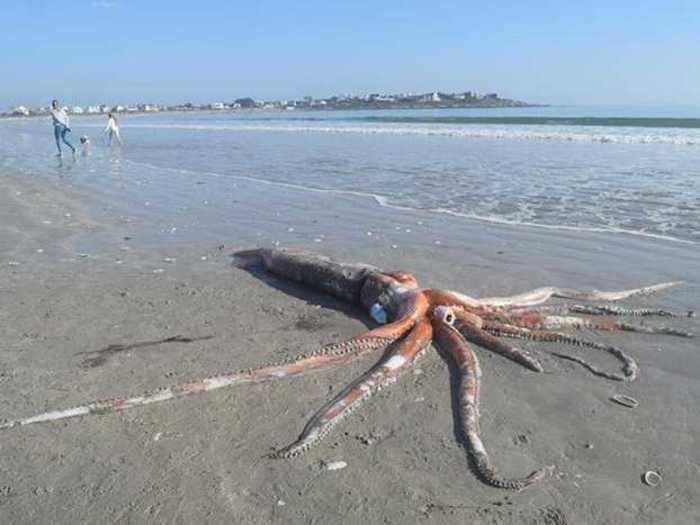
A rare giant squid specimen washed up on Golden Mile Beach in Brittania Bay on June 7, 2020.Adéle Grosse © Iziko Museums of South Africa
Thousands of feet under the waves, in the darkest parts of the ocean, carnivorous giant squids hunt with long, grasping tentacles, chomping on prey with ferocious beaks.
Because the squids almost never leave those crushing depths, scientists know very little about them. That's part of the reason the mysterious creatures have inspired tales of the kraken: a legendary sea monster that attacks ships and pulls them underwater.
Most of what we know about the giant squid comes from carcasses that wash ashore, or from digested squid appendages found in sperm-whale stomachs (the squid's main predator).
Often these remains are piecemeal, so researchers don't have much to study. But on June 7, a nearly intact giant squid washed ashore in South Africa, offering biologists a golden opportunity to glean further insights into the creatures' anatomy and sample some rare DNA.
Researchers at the Iziko Museums of South Africa collected the nearly 14-foot-long squid and brought it back to the museum for preservation.
These photos from that effort reveal the creature's size and impressive tentacles.

When they found the creature, it was already dead.
"We looked for bite marks or injuries and could not really find anything," Grosse told Live Science.
Another beachgoer, Richard Davies, said he captured footage of the squid's dying breaths after he was unable to roll it back into the ocean.
"It was still pumping out ink and I touched one of its tentacles, which sucked onto my hand, and I actually had to use some force to remove it," he told local news outlet News24.

Florence and his colleagues collected the creature's DNA and are temporarily storing it at minus 22 degrees Fahrenheit in a walk-in freezer facility.
Once the country's coronavirus lockdown ends, they plan to preserve the squid long-term in a giant stainless steel tank filled with ethanol.

"It's rare. In South Africa, we have had less than a handful of strandings. Surprisingly, despite our museum being almost 200 years old, our earliest stranded giant squid specimen is from 1972," he told News24.

Sightings are so rare, in fact, that scientists for a while thought the moniker "giant squid" comprised several species.
But a 2013 study based on DNA analysis of 43 squid specimens from around the world revealed they were all part of the same species: Architeuthis dux.
If, however, the DNA from this new squid doesn't match that of Architeuthis dux, it could throw cold water on the single-species theory.

According to Grosse and Davies' estimates, this new squid was 13.7 feet long and weighed at least 660 pounds. The smaller size suggests this squid was fairly young — scientists can estimate its age using the squid's length and beak size.
"This beast was probably less than two years old," Florence told News24.
Typically, squid only live five years.

These tentacles help the squid pull prey from more than 30 feet away into its gaping maw. It uses its beak to chomp prey into bite-sized chunks.

Like other squids and octopi, giant squids have ink sacs and can squirt ink to deter predators.

The elusive denizens prefer deep water, since their foot-wide, dinner-plate-sized eyes enable them to spot prey in almost complete darkness.
They almost never leave the icy depths of their habitat, up to 3,300 feet (about 1,000 meters) beneath the waves.

The researchers filmed it nearly 3,000 feet deep in Japan's Ogasawara archipelago by using flashing lights to imitate other bioluminescent creatures of the deep.

Researchers on a National Oceanic and Atmospheric Administration expedition captured a stunning video of this squid in the Gulf of Mexico, 100 miles southeast of New Orleans.
 I spent $2,000 for 7 nights in a 179-square-foot room on one of the world's largest cruise ships. Take a look inside my cabin.
I spent $2,000 for 7 nights in a 179-square-foot room on one of the world's largest cruise ships. Take a look inside my cabin. Colon cancer rates are rising in young people. If you have two symptoms you should get a colonoscopy, a GI oncologist says.
Colon cancer rates are rising in young people. If you have two symptoms you should get a colonoscopy, a GI oncologist says. Saudi Arabia wants China to help fund its struggling $500 billion Neom megaproject. Investors may not be too excited.
Saudi Arabia wants China to help fund its struggling $500 billion Neom megaproject. Investors may not be too excited. Catan adds climate change to the latest edition of the world-famous board game
Catan adds climate change to the latest edition of the world-famous board game
 Tired of blatant misinformation in the media? This video game can help you and your family fight fake news!
Tired of blatant misinformation in the media? This video game can help you and your family fight fake news!
 Tired of blatant misinformation in the media? This video game can help you and your family fight fake news!
Tired of blatant misinformation in the media? This video game can help you and your family fight fake news!

Copyright © 2024. Times Internet Limited. All rights reserved.For reprint rights. Times Syndication Service.